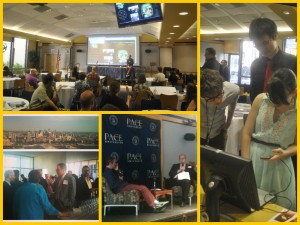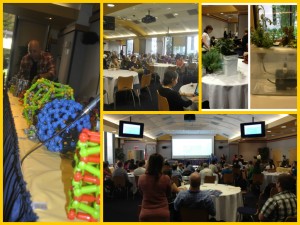In case you missed out on the AOL Social Media Salon at AOL’s Headquarters on 770 Broadway on May 21st, we’re here for you. Seidenberg had a group of enthusiastic attendees, pictured above, and here you’ll find out the most interesting bits of the night including the helpful information that the panel of guests had to offer.
In case you missed out on the AOL Social Media Salon at AOL’s Headquarters on 770 Broadway on May 21st, we’re here for you. Seidenberg had a group of enthusiastic attendees, pictured above, and here you’ll find out the most interesting bits of the night including the helpful information that the panel of guests had to offer.
Our host, Matthew Knell, AOL’s social media director and a graduate of Pace’s School of CSIS (class of 2000), presented for us the panel:

From left to right we have Katie Morse, the social marketing manager at Billboard, Matthew Knell himself, Devin Desjarlais, the social media director at Omaze, Tim McDonald, the community manager at HuffPost Live, and Meg Peters, the community director at Mashable.
The event was held as part of Internet Week New York (#iwny), a festival devoted to exploration of how business, technology, and culture intersect. The goal of this event in particular was to clarify the differences between Social Media and Community Management. After singing ‘Happy Birthday’ to Devin Desjarlais, the panel tackled the initial question of “Are social media and community management the same thing?” The overall response was a resounding ‘no,’ the two are not equivalent or interchangeable, but work together, as Devin put it, “like best friends.” The differences were described in terms of proactivity and reactivity. Social Media gets the message out, and Community Management draws people in.
With that said, the panel then discussed how their work is organized around Social Media and Community Management, and whether there is a distinct line of division between the two fronts or if that line is undetectable. They all agreed that there was no distinguishing line, and Meg Peters added that the end goal for both Social Media and Community Management is to allow the readers’ voices to be heard. The readers offer important criticism and advice and it is always important to listen to those comments in order to best improve the readers’ experience.
When the panel was asked about brands’ access to their audiences, it was clear that there usually is a line. Katie Morse said she is “like the gate-keeper.” She will allow sponsored tweets but there is a maximum amount per week and the tweets must always coincide with what Billboard envisions and wants. They use benchmarks to track the success of sponsored tweets in relation to Billboard.
So then, can a Social Media channel have a community? Most of the panel answered ‘yes,’ stating that the channels allow people to connect to one another, generating a community of sorts via threads. Tim McDonald answered ‘no,’ and clarified that “community is community,” and that social media is a way of accessing that community rather than generating it.
The panel then talked about how they measure the success of their Social Media and Community Management forces. Tim claimed to not focus on hard numbers to measure success and instead worry about increasing productivity while overall figuring out how to gain easy access to the information of willing participants. Meg and Katie both shared that they were inclined to use metric data to measure the success of their initiatives, but were mostly concerned with the engagement of their audiences.
For anyone involved in business, Social Media and Community Management are unavoidable in this day in age. Not even are they just unavoidable, but they are crucial as a business stimulus (or detriment, if handled poorly). Students of Seidenberg (and even Lubin and Dyson) are encouraged to hone their skills in managing community affairs and social media forces.
A few students from Seidenberg were able to reserve a spot at the event. Julie Gauthier, a rising junior, Computer Science major, says she learned a lot about large business management via social media. She states “It’s closely tied into marketing, but it’s a far more interpersonal relationship with a fanbase, or a variety of fan-bases.” She also claimed that the information is directly relatable to her position as a digital marketer for a small company in Connecticut. Another student, Sabiya Bacchus, also a rising junior, Computer Science major, after attending the panel discussion, learned that “it’s imperative to understand your target audience/readers, because only then can you maximize their experience, which will inevitably help you achieve your goal (whatever it may be).”
After taking all this new information in, we (the bloggers, social media controllers, and community managers in Seidenberg) have started to wonder about other branches that may be less obvious forms of community management. For example, the Student Government Association. Are positions within SGA considered to be Community Management positions? If so, how are these officers using Social Media to amplify their information to the right audiences? Not only SGA, but how are clubs, greek houses, or any other groups keen on keeping a specific group of students involved, informed, and engaged using technology to their advantage?
As a side note, other tips for Social Media channels include:
– Be aware of the fine balance between entertaining posts and posts that advertise.
– People will tune out repetitive posts; keep your feed interesting and lively.
– Do not buy likes (companies will try to sell 10,000 likes/followers for $500, for example). They are neither genuine nor interactive, and when the number of followers/likes of a page does not correspond with the likes of popular posts, those numbers will reflect poorly on the brand/company/group.
 “In reality there is no one ‘best way’ to defend against cyber attacks because the path towards safe computing practices that could thwart attacks has been lengthy, evolving and unclear.” Read more
“In reality there is no one ‘best way’ to defend against cyber attacks because the path towards safe computing practices that could thwart attacks has been lengthy, evolving and unclear.” Read more


